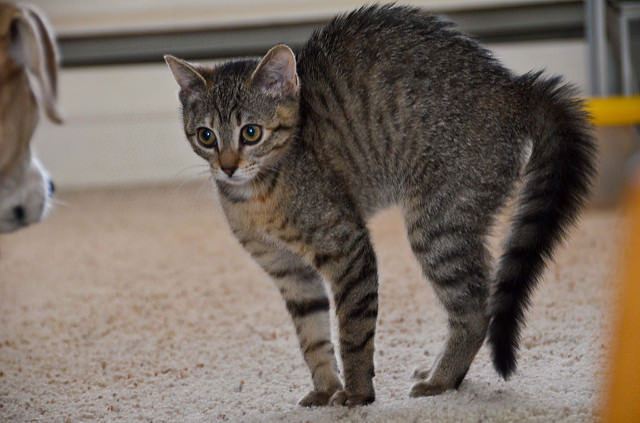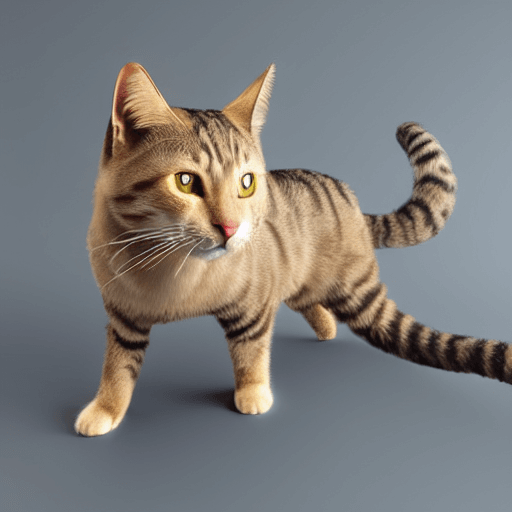Cats are fascinating creatures that never cease to amaze us with their quirky and amusing behavior. One such behavior that often leaves cat owners puzzled is the sudden puffing up of their cat’s tail during playtime. It’s a sight that can be both cute and intimidating at the same time. But have you ever wondered why cats tails puff up when playing?
The answer lies in the feline’s natural instincts. A cat’s tail is a vital communication tool that they use to express their emotions and intentions. Puffing up the tail is one of the many ways in which cats communicate, especially during playtime. Understanding this behavior can help us better understand our feline friends and strengthen our bond with them. So, let’s dive deeper into the reasons behind this curious behavior of cats.
When cats are playing, their tails puff up as a sign of excitement or agitation. This reaction is caused by the release of adrenaline, which triggers the muscles in the tail to expand. It’s a common behavior for cats, and it’s essential to understand that it doesn’t always indicate aggression. A cat’s tail can also puff up when they are scared or feeling threatened. If your cat’s tail is puffed up while playing, it’s best to let them calm down before interacting with them again.

Why Do Cats Tails Puff Up When Playing?
When cats are playing, it’s not uncommon for their tails to puff up. This behavior can be puzzling for cat owners, leaving them wondering what it means. In this article, we’ll explore the reasons behind this curious feline behavior.
1. Emotional Response
When cats are feeling threatened or frightened, their tails will often puff up as a display of aggression. However, when cats are playing, their tails may also puff up as an emotional response to the excitement and stimulation of playtime.
Playing is a natural way for cats to relieve stress and burn off energy, and the physical activity of play can trigger a range of emotions. When cats feel happy or excited, their tails may puff up as a way to express their emotions and communicate with their playmates.
Some cats may also puff up their tails as a way to intimidate their playmates or assert their dominance during playtime. This behavior is especially common in multi-cat households where cats may compete for resources or attention.
2. Physical Response
Another reason why cats’ tails may puff up during play is a physical response to the excitement of the game. When cats are fully engaged in play, their bodies will often become more tense and their muscles may tighten.
This physical response can cause their tails to puff up, much like a dog’s fur will stand on end when they are excited or aroused. In some cases, cats may also arch their backs or raise their hackles as a physical response to playtime.
3. Communication
Cats use their tails to communicate a wide range of emotions and messages to other cats and humans. When a cat’s tail is puffed up, it can be a sign that they are feeling threatened, frightened, or agitated.
However, when a cat’s tail is only partially puffed up, it can indicate that they are feeling happy, excited, or playful. By paying attention to the position and movement of their cat’s tail, owners can gain valuable insight into their pet’s emotional state during playtime.
4. Benefits of Puffed Up Tails
While it may seem odd or alarming to see a cat’s tail puff up during playtime, it’s actually a sign that they are having fun and enjoying themselves. The physical and emotional responses that cause a cat’s tail to puff up can help them release stress, bond with their playmates, and engage in healthy physical activity.
For owners, watching their cats play and puff up their tails can be a source of entertainment and joy. By providing cats with plenty of opportunities for play and stimulation, owners can help their pets lead happy and healthy lives.
5. Puffed Up Tails Vs Other Behaviors
It’s important for cat owners to distinguish between a puffed up tail during playtime and other behavioral cues that may indicate aggression, fear, or anxiety. When a cat’s tail is fully puffed up and their ears are pinned back, it can be a sign that they are feeling threatened or frightened.
Other indications of stress or anxiety in cats include hiding, hissing, growling, or aggressive behavior. If owners notice any of these behaviors during playtime or in other situations, it’s important to take steps to address the underlying cause and provide their cats with the support they need.
6. Conclusion
In conclusion, cats’ tails may puff up during playtime as a physical and emotional response to the excitement and stimulation of the game. This behavior can be a sign of happiness, excitement, or even dominance, and is a natural way for cats to communicate with their playmates and express their emotions.
By providing cats with plenty of opportunities for play and stimulation, owners can encourage healthy physical activity and help their pets lead happy and fulfilling lives. With a better understanding of their cats’ behavior and communication cues, owners can strengthen their bond with their pets and enjoy a more rewarding relationship.
Frequently Asked Questions
Why do cats tails puff up when playing?
When cats play, they tend to get excited and their tails may puff up. This is a natural reaction that occurs when a cat is feeling threatened, excited or agitated. The puffed-up tail is a sign of emotional arousal, and it is a way for the cat to communicate with its surroundings. When the cat’s tail is puffed up, it is a warning sign to other animals or humans to back off.
When a cat is playing, it may also puff up its tail as a way to show off its agility and balance. The tail helps the cat to maintain its balance and it serves as a counterweight during jumps and other acrobatic moves. In addition, the puffed-up tail can make the cat appear larger and more intimidating, which can be useful when playing with other cats or animals. Overall, a puffed-up tail is a natural and common behavior in cats, and it is nothing to be alarmed about.
Is a puffed-up tail a sign of aggression in cats?
A puffed-up tail in cats is not always a sign of aggression. While it is true that cats may puff up their tails when they are feeling threatened or agitated, it can also be a sign of excitement or playfulness. When a cat is playing or feeling playful, it may puff up its tail as a way to communicate with its surroundings. This is especially true when cats are playing with each other or with toys.
However, if a cat’s tail is puffed up and its ears are flattened against its head, it may be a sign of aggression. This is a warning sign that the cat is feeling threatened or angry, and it may be best to give the cat some space. It is important to pay attention to a cat’s body language and to read the other signs that the cat is giving off in order to determine its mood and intentions.
Can a cat’s tail be injured when it is puffed up?
While a puffed-up tail is a natural behavior in cats, it is possible for a cat’s tail to become injured when it is in this state. When a cat’s tail is puffed up, it is more vulnerable to injury because it is less flexible and less able to move quickly. This is especially true if the cat is in a high-stress situation or if it is playing rough with other cats or animals.
If a cat’s tail is injured while it is puffed up, it may cause the cat pain and discomfort. In some cases, the cat may need to see a veterinarian in order to receive treatment for the injury. It is important to monitor a cat’s behavior and to seek veterinary care if there are any signs of injury or discomfort.
How can I tell if my cat is feeling threatened?
There are several signs that a cat may display when it is feeling threatened. One of the most common signs is a puffed-up tail, which is a warning sign that the cat is feeling agitated or threatened. Other signs of a threatened cat may include flattened ears, hissing or growling, and an arched back.
It is important to pay attention to a cat’s body language and to read the other signs that the cat is giving off in order to determine its mood and intentions. If a cat is feeling threatened, it is best to give the cat some space and to avoid approaching it until it has calmed down.
Is it okay to play rough with my cat?
While playing with your cat can be a fun and rewarding experience, it is important to play in a safe and gentle manner. Cats are delicate animals, and they can be easily injured if they are played with too roughly. Rough play can also cause a cat to become stressed, anxious or aggressive.
When playing with your cat, it is important to use toys that are safe and appropriate for cats. It is also important to avoid using your hands or other body parts as toys, as this can encourage your cat to bite or scratch. In addition, it is important to monitor your cat’s behavior and to stop playing if the cat becomes agitated or stressed. Overall, it is best to play gently and safely with your cat in order to ensure that both you and your cat have a fun and enjoyable experience.

What Does It Mean When A Cat’s Tail Is Puffed Out?
As a professional writer, I can confidently say that cats are fascinating creatures. Their behavior often leaves us in awe, and one of the most intriguing aspects of their behavior is when their tails puff up during playtime. While many cat owners may have noticed this behavior, few know the reasons behind it.
Cats’ tails puff up when playing as a form of communication. It is a sign that they are excited and stimulated, and it is their way of expressing their emotions. Additionally, a puffed-up tail can serve as a warning to other cats, indicating that they are not to be messed with. So, the next time you see your furry friend’s tail puff up during playtime, know that it is their way of telling you that they are having fun and enjoying themselves. In conclusion, understanding your cat’s behavior is essential for building a strong bond with them, and knowing why their tails puff up during playtime is just one piece of the puzzle.
